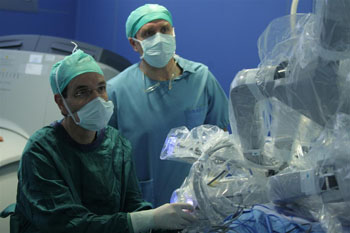Por primera vez en España un equipo de cirujanos realiza una cirugía robótica de tiroides sin cicatriz en el cuello
For the first time in Spain, a team of surgeons performs scarless robotic thyroid surgery on the neck
Thyroid Pathology specialists of the Clinic have successfully performed the first three interventions through the axilla.

The surgical team of the area of Thyroid Pathology of the Clínica Universidad de Navarra has so far performed three cases of transaxillary thyroid surgery (through the armpit) using the Da Vinci robot with satisfactory results. This is the first time that a Spanish hospital center has operated on thyroid pathology using this robotic technique. The main benefit of the new procedure is aesthetic, since it avoids the cervical scar typical of conventional thyroid surgery. The surgical team of the Thyroid Pathology area is composed of doctors Fernando Martínez-Regueira (General Surgery), Juan Alcalde and Peter Baptista (both specialists in Otorhinolaryngology).
The transaxillary robotic technique is mainly indicated for the removal of nodular goiter (enlargement of the thyroid gland caused by the presence of nodules in its interior), follicular thyroid carcinomas no larger than 2 cm, without extracapsular extension and parathyroid gland adenomas (hyperparathyroidism). This is a particularly advantageous procedure in thin patients with nodular thyroid pathology.
Transaxillary technique
According to Dr. Alcalde, robotic thyroid surgery represents "on the one hand, an important technological advance, since without the precision of the robot it would be excessively difficult to perform this technique with a single incision in the axilla. On the other hand, it constitutes a great aesthetic benefit since the scar is hidden". In spite of the important advances made in recent years towards minimally invasive thyroid surgery, the specialist points out that, "although in general the esthetic result that conventional surgery leaves on the neck is acceptably good, sometimes a hypertrophic scar or scar adhesion can be generated on the underlying muscular plane (which remains below), with the esthetic deterioration that this entails".
The robotic technique replaces the cervical incision with a transaxillary approach (through the axilla), through an incision of about 6 cm that is hidden in the folds of the axilla. In order to perform this procedure it is necessary for the surgical team to have extensive experience in surgery of the thyroid gland. In this sense, the specialists of the Thyroid Pathology area have more than 2,000 cases performed to date, in addition to a specific training in robotic surgery with the Da Vinci system, complemented, in the case of Dr. Alcalde and Dr. Baptista, by the internship transoral robotic surgery.
Precision and duration
Surgical dissection from the axilla is performed in the subcutaneous plane until reaching the cervical and thyroid region. Thanks to the excellent visualization provided by the robotic equipment and the precision in the use of instruments such as the "harmonic" scalpel - which divides and seals the vascular Structures and is specially designed for this surgery - the removal of the thyroid gland can be carried out. For these cases, robotic surgery is approximately one hour longer than conventional thyroid surgery, since the surgical path from the armpit to the thyroid gland is longer. However, Dr. Alcalde emphasizes that in the transaxillary procedure "the surgical time for exeresis (removal) of the gland, in cases in which a hemithyroidectomy (surgical removal of half of the gland) is performed, is similar to employee in the classic technique, with identical anatomical preservation of the Structures surrounding the gland".
At final, for the intervention of this pathology, the Da Vinci robot "provides good vision and excellent handling of the instruments without the need to introduce gas, as is required in laparoscopic techniques", points out Dr. Alcalde.
reference letter in robotic surgery
As a pioneer in Spain, Clínica Universidad de Navarra has experience in the surgical treatment of different pathologies by means of robotic surgery. Apart from radical prostatectomy for the surgical treatment of prostate cancer (an indication also extended in other hospitals with Da Vinci), specialists at the Clinic have been the first to operate with the robot on Obstructive Sleep Apnea Syndrome, by means of the partial removal of the lingual tonsil, with an approach through the oral cavity (transoral). Likewise, they have been the first Spanish surgeons to also operate with robotic surgery a larynx cancer with the same subject transoral approach.
